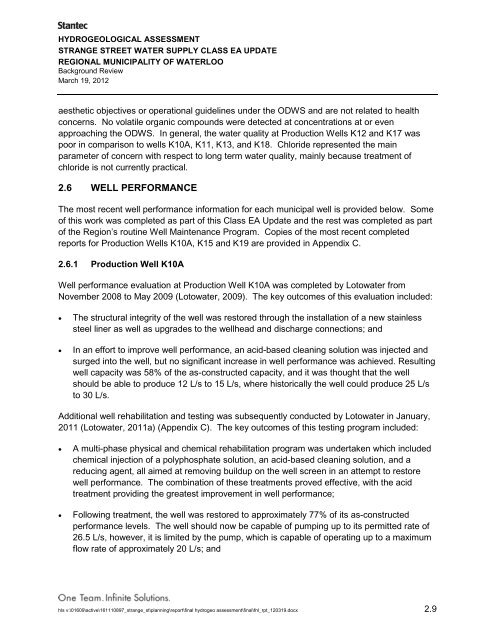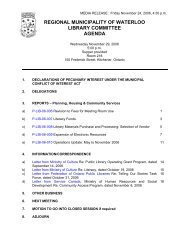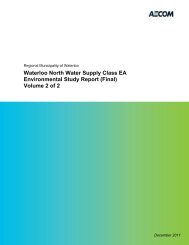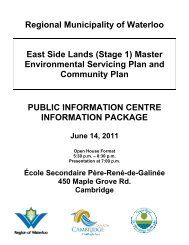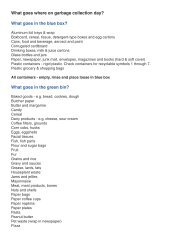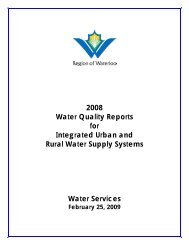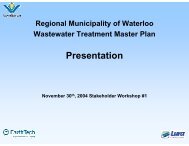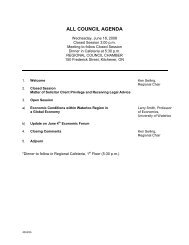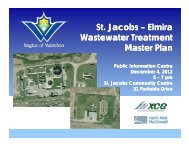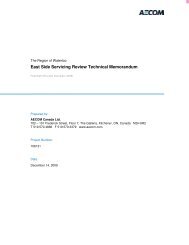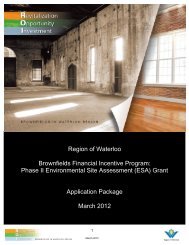Sam Ziemann From - Region of Waterloo
Sam Ziemann From - Region of Waterloo
Sam Ziemann From - Region of Waterloo
Create successful ePaper yourself
Turn your PDF publications into a flip-book with our unique Google optimized e-Paper software.
HYDROGEOLOGICAL ASSESSMENTSTRANGE STREET WATER SUPPLY CLASS EA UPDATEREGIONAL MUNICIPALITY OF WATERLOOBackground ReviewMarch 19, 2012aesthetic objectives or operational guidelines under the ODWS and are not related to healthconcerns. No volatile organic compounds were detected at concentrations at or evenapproaching the ODWS. In general, the water quality at Production Wells K12 and K17 waspoor in comparison to wells K10A, K11, K13, and K18. Chloride represented the mainparameter <strong>of</strong> concern with respect to long term water quality, mainly because treatment <strong>of</strong>chloride is not currently practical.2.6 WELL PERFORMANCEThe most recent well performance information for each municipal well is provided below. Some<strong>of</strong> this work was completed as part <strong>of</strong> this Class EA Update and the rest was completed as part<strong>of</strong> the <strong>Region</strong>’s routine Well Maintenance Program. Copies <strong>of</strong> the most recent completedreports for Production Wells K10A, K15 and K19 are provided in Appendix C.2.6.1 Production Well K10AWell performance evaluation at Production Well K10A was completed by Lotowater fromNovember 2008 to May 2009 (Lotowater, 2009). The key outcomes <strong>of</strong> this evaluation included:• The structural integrity <strong>of</strong> the well was restored through the installation <strong>of</strong> a new stainlesssteel liner as well as upgrades to the wellhead and discharge connections; and• In an effort to improve well performance, an acid-based cleaning solution was injected andsurged into the well, but no significant increase in well performance was achieved. Resultingwell capacity was 58% <strong>of</strong> the as-constructed capacity, and it was thought that the wellshould be able to produce 12 L/s to 15 L/s, where historically the well could produce 25 L/sto 30 L/s.Additional well rehabilitation and testing was subsequently conducted by Lotowater in January,2011 (Lotowater, 2011a) (Appendix C). The key outcomes <strong>of</strong> this testing program included:• A multi-phase physical and chemical rehabilitation program was undertaken which includedchemical injection <strong>of</strong> a polyphosphate solution, an acid-based cleaning solution, and areducing agent, all aimed at removing buildup on the well screen in an attempt to restorewell performance. The combination <strong>of</strong> these treatments proved effective, with the acidtreatment providing the greatest improvement in well performance;• Following treatment, the well was restored to approximately 77% <strong>of</strong> its as-constructedperformance levels. The well should now be capable <strong>of</strong> pumping up to its permitted rate <strong>of</strong>26.5 L/s, however, it is limited by the pump, which is capable <strong>of</strong> operating up to a maximumflow rate <strong>of</strong> approximately 20 L/s; andhls v:\01609\active\161110897_strange_st\planning\report\final hydrogeo assessment\final\fnl_rpt_120319.docx 2.9


